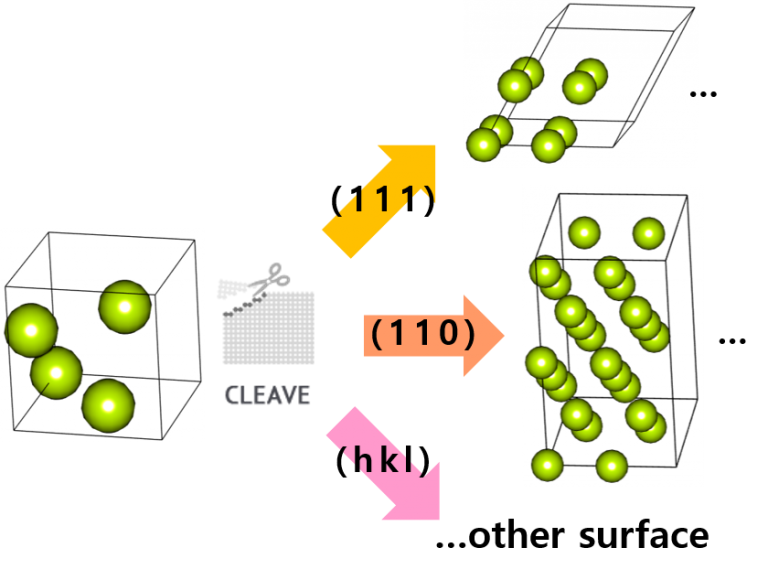If you decide which system will be simulated, you need to prepare a model to be used for calculation. To simulate a homogeneous bulk system, use periodicity to repeat unit cells to be used as a bulk system. Unfortunately, it is difficult to make a perfect surface because of periodicity when modeling the surface of a solid. Thus, it needs to model a “slab structure” to simulate a surface structure.
1. Slab Structure Modeling
A slab structure is created by adding vacuum in the direction to an axis of a cell. If a vacuum of 10 Å or more is given sufficiently to the c-axis, the interaction between repeated materials on the surface toward the c-axis can decrease to the state so that it can be ignored. A slab structure can be made in MatSQ by taking the following steps:
- Optimize the unit cell structure.
- Create a sufficiently large supercell using the Clone menu.
- Add sufficient vacuum using the Vacuum menu.

The unit cell can be reproduced, and the vacuum can be added using the Clone menu and the Vacuum menu. At the time, if you perform the vc-relax calculation and use the unit cell with the completed structural optimization, you can reduce the calculation time of the slab structure.
After creating the slab structure, right-click the Structure Builder to display a popup window, and click Ghost checkbox to activate. Then, it is found that the structure is periodically repeated including vacuum. The surfaces contacting the vacuum are the top and bottom of a model. Thus, the slab structure model has two surfaces. The next figure shows a colored Aluminum 100 slab, and the top and bottom regions of material become surfaces.

Thus, when creating a slab structure, moderately clone the unit cell toward the axis where the vacuum is given to decrease the ratio of the region to be considered as the surface. As the movement caused by vibration may affect the third and fourth layers from the outermost atomic layer, it is proper to create six or more atomic layers. At the time, as the bulk section may have a smaller change compared with the surface, the coordination of atoms can be fixed using the “fix atom” function of the QE module to assume that the atoms are the structure of the bulk region.
2. Surface Modeling with Specific Orientation
To make 100, 010, and 001 surfaces, you just need to give vacuum to the unit cell. However, for the surface in a different direction, use the Cleave menu. This menu gives a function to cut s surface according to the miller index.

In the Cleave menu, you should enter the miller index and the maximum z. Click Apply. Then, the surface that is cut according to the miller index becomes a new ab plane. The structures, which are shorter than the z-axis length and set in an available c-axis, are displayed. At the time, if you select the structure which has angle values of many 90˚, the axis is similar to the Cartesian axis, so it is easy to handle.
Select a desired structure among the displayed structures, reproduce the selected unit cell to a proper size, and give the vacuum to the c-axis. Then, the slab structure with the desired surface is completed.
If there is no finding structure and you want to perform the cleaving process again, be careful that the process starts from the structure seeing from the visualizer canvas. Click the original structure to cleave again and click Apply.
3. Adsorption Structure Modeling
A structure where molecules or atoms are adsorbed on a slab surface can be modeled as follows:

In the Molecule tab of the Add Atom menu, a molecule, atom, or nanostructure can be added.
To add a molecule in the Molecule tab, click “Draw New Molecule” to pop up the molecule drawing window. Draw a molecule on the window and click Done. As hydrogen is automatically added when drawing a molecule, add charges to remove unnecessary hydrogen. (The charges are not applied in the actual calculation.)
If an adsorbate molecule is added, you can move it to the desired location using the Move & Rotate menu. On the other hand, you can directly modify the coordinate of the selected atom in the Edit menu, or use arrow keys and shortcut keys to move it by 1 Å.
👉 See the List of Shortcut Keys
With this weekly tip #9, we have learned how to create a slab structure, create a structure in the direction of a specific surface, and make diverse models by applying a slab structure. The next weekly tip will cover how to calculate the adsorption energy.
https://www.materialssquare.com/blog/9-how-to-create-surface-under-periodic-boundary-condition

0 Comments